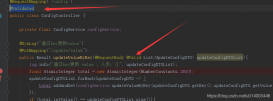本文实例讲述了Java实现的文件上传下载工具类。分享给大家供大家参考,具体如下:
这是一个在Eclipse环境下采用Java语言实现文件上传下载的工具类。和之前介绍的C#文件上传下载工具类一样,在上传时,为避免文件名在服务器中重复,采用“服务器时间(定义到毫秒)+文件名+文件后缀“的方式作为服务器上的文件名;下载过程中利用 spring mvc ResponseEntity 做文件下载,返回的是字节流,下载成功后可自定义文件的保存路径。
具体源码如下所示:
|
1
2
3
4
5
6
7
8
9
10
11
12
13
14
15
16
17
18
19
20
21
22
23
24
25
26
27
28
29
30
31
32
33
34
35
36
37
38
39
40
41
42
43
44
45
46
47
48
49
50
51
52
53
54
55
56
57
58
59
60
61
62
63
64
65
66
67
68
69
70
71
72
73
74
75
76
77
78
79
80
81
82
83
84
85
86
87
88
89
90
91
92
93
94
95
96
97
|
package com.utils;import java.io.File;import java.io.IOException;import java.io.InputStream;import java.io.UnsupportedEncodingException;import java.text.SimpleDateFormat;import java.util.Date;import org.apache.commons.io.FileUtils;import org.springframework.http.HttpHeaders;import org.springframework.http.HttpStatus;import org.springframework.http.MediaType;import org.springframework.http.ResponseEntity;/** * 文件上传下载工具类 * */public class FileHelper { /** * 根据路径确定目录,没有目录,则创建目录 * * @param path */ private static void createDir(String path) { File fileDir = new File(path); if (!fileDir.exists() && !fileDir.isDirectory()) {// 判断/download目录是否存在 fileDir.mkdir();// 创建目录 } } /** * 将文件名解析成文件的上传路径 * * @param fileName * @return 上传到服务器的文件名 */ public static String transPath(String fileName, String path) { createDir(path); Date date = new Date(); SimpleDateFormat dateformat = new SimpleDateFormat("yyyyMMddhhmmssSSS");// 定义到毫秒 String nowStr = dateformat.format(date); String filenameStr = fileName.substring(0, fileName.lastIndexOf("."));// 去掉后缀的文件名 String suffix = fileName.substring(fileName.lastIndexOf(".") + 1);// 后缀 if (fileName.trim() != "") {// 如果名称不为"",说明该文件存在,否则说明该文件不存在 path += "\\" + filenameStr + nowStr + "." + suffix;// 定义上传路径 } return path; } /** * 提醒文件下载 * * @param fileName * @param path * @return */ public static ResponseEntity<byte[]> downloadFile(String fileName, String path) { try { fileName = new String(fileName.getBytes("GB2312"), "ISO_8859_1");// 避免文件名中文不显示 } catch (UnsupportedEncodingException e1) { e1.printStackTrace(); } File file = new File(path); HttpHeaders headers = new HttpHeaders(); headers.setContentType(MediaType.APPLICATION_OCTET_STREAM); headers.setContentDispositionFormData("attachment", fileName); ResponseEntity<byte[]> byteArr = null; try { byteArr = new ResponseEntity<byte[]>(FileUtils.readFileToByteArray(file), headers, HttpStatus.OK); } catch (IOException e) { e.printStackTrace(); } return byteArr; } /** * 将输入流中的数据写入字节数组 * * @param in * @return */ public static byte[] inputStream2ByteArray(InputStream in, boolean isClose) { byte[] byteArray = null; try { int total = in.available(); byteArray = new byte[total]; in.read(byteArray); } catch (IOException e) { e.printStackTrace(); } finally { if (isClose) { try { in.close(); } catch (Exception e2) { System.out.println("关闭流失败"); } } } return byteArray; }} |
希望本文所述对大家java程序设计有所帮助。
原文链接:http://blog.csdn.net/jianyuerensheng/article/details/78188621















